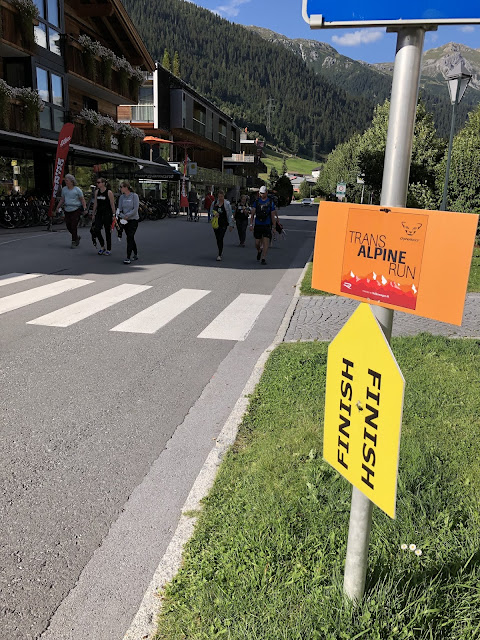An eight stages Dynafit Transalpine Run is known event in the ultra-running and adventure racing communities for couple of years already. As part of 264km long endurance event, there’s also a “kids” version consisting of first two stages - this year about 64kms with almost 4000 m elevation gain (in 2 days).
Dynafit Transalpine Run (TAR) is
not trying to act as the toughest stage race in Europe. It is tough already by
a nature and more tough it gets with bad weather … or too good weather due to
unbearable heat (depends on how man can handle such conditions). TAR might not
be toughest race in Europe or world, but still, it can give a hard time to many
experienced athletes. TAR is “that” kind of a race where you can have luck when
finishing … but the more prepared and trained you are for such race, the more
luck you have :-)
Organization
For newbies, the instructional e-mails might be quite a long … lots of information contained in the mails might cause slight confusion and to be honest, you can get lost of “what you need to pay attention and what’s not so important”. From my point of view, the mails could have bit more simple part with just bullet points.
Like the ones below - what you
really need first:
- Get registered (obviously)
- Buy a car park ticket, if you go with car on your own (no support traveling along the course with your car)
- Buy ticket for transport from destination back to start (where you left the car)
- Buying pasta party tickets for whole duration is highly recommended (saves you time, worries and in most of the cases even money)
- No need to book / prepay merchandise goods. All of it you will get during the registration process
Race director Martin Hafenmair (interview
here - it’s in Czech, but Google translate will do the job) is charismatic mountaineer,
who really cares about the race and all people around - organizers, mountaineers,
supporters, land lords owning the land where race passes through and the races
self. He’s very enthusiastic and does all by his heart. He’s waiting the racers
at exposed parts of the daily stages cheering people up, collecting feedbacks
and he is really listening.
Every evening before next day
stage there’s next stage briefing - or live at pasta party premises or recorded
on YouTube channel where each participant must confirm he has listened to the
briefing as this is one of the most important parts of the following race day.
Martin shares the course description, highlights the dangerous parts, and
defines equipment requirements for the upcoming day (snow/ice passes have more
strict mandatory equipment conditions).
Race rules are very reasonable.
All focused on the safety of the race participants and organizers. At the
starting corridor entrance, there are mandatory equipment checks. These are
randomly selecting 3 items of the equipment list. Both team members have to
prove the possession of requested items. However, TAR is not concerned just by
safety, but also on environmental responsibility and gels, ion drinks and all
waste shall be signed with your starting race number to easily identify racer
who dropped the litter.
Finally, you shall not start as
an individual. Always in a team of 2 or three. Which means - your partner drops
out, but you can still find match of similarly disbanded team or you can join
another team of 2. The day stage you must take then together with that group.
If not possible to keep the pace, you must match through the day with someone pacing
same speed.
The equipment
Magic of such stage race is that organizer
manages pickup and delivery of your stage drop bags from and to the hotel which
you have indicated. That’s perfect since you don’t need to take care of
carrying the large bags everyday evening and morning.
Daily at the evening pasta party
or later online on YouTube, there’s race briefing available for you to find
what’s the next day’s weather, mandatory equipment changes - for example if you’re
about to pass the snow / ice parts, the steel crampons are required.
For the stage itself, you’re just
required with few requirements and required items can fit easily into 6-10
liters backpack/vest. That’s pretty good considering total race distance of 264km.
But day stages are usually no longer than 30-40km. Sometimes longer, sometimes
shorter, but standard mountain marathon equipment shall suffice.
Pit stops (refreshment points)
are placed in reasonable distances. Reasonable for experienced mountain racers.
Newbies might be surprised when they run out of water, but still, it’s
manageable and you can go easily with 1liter of water in between each station.
The stations are well supplied
with water, ion, cheese, sausage, orange, cucumber, lots of other stuff you
really want to eat at the time you reach the stops.
Environment, people, atmosphere
Well, all is family. If you check
on the post stage videos on TAR YouTube channel, you’ll find out there’s lot of
people who participate in TAR regularly. They love it, they take every year
vacation to take on the Alps challenge. The journey that takes them every year
to different parts, but every year is as hard as hell to make it to the finish
line. People helping each other regardless the race position. If you’re in
trouble, you have good buddies around all the time. Even organizing company staff
is .. just brilliant.
I really do recommend this race.
The atmosphere and experience is … per feelings way better than some other famous
racers in Europe.






